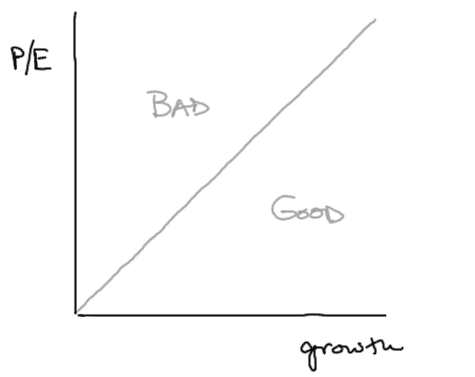
- Wednesday, February 10th, 2010
- unpegged
-
Investors are prone to using rules of thumb (high-falutin’ folks now use the term “heuristics”) to help in navigating the markets. One of the most common looks like this:
 Yes, it’s the famous PEG ratio, which is widely given as a reason to embrace or avoid a stock depending on which side of that line its numbers line up on. Many individual investors cling to it as a guide, and it’s amazing how often professional investors cite this relationship in marketing materials, articles, and television appearances. Go to Investopedia and one of its featured articles explains why: “Stock theory suggests that the stock market should assign a PEG ratio of one to every stock.”Investopedia | The title of the piece is “PEG Ratio Nails Down Value Stocks.” Well, no.
Yes, it’s the famous PEG ratio, which is widely given as a reason to embrace or avoid a stock depending on which side of that line its numbers line up on. Many individual investors cling to it as a guide, and it’s amazing how often professional investors cite this relationship in marketing materials, articles, and television appearances. Go to Investopedia and one of its featured articles explains why: “Stock theory suggests that the stock market should assign a PEG ratio of one to every stock.”Investopedia | The title of the piece is “PEG Ratio Nails Down Value Stocks.” Well, no.The history of this myth is of interest. When Peter Lynch shepherded Fidelity Magellan to extraordinary gains, he became the first investment star to “go platinum.” He was copied widely by other managers and, with the increased democratization of the market, by individuals too. The main tenets of his philosophy could be described as “buy what you know” and “look for cheap growth.” Each has come to be applied beyond reason, the latter resulting in senseless application of the PEG ratio.
In looking at that calculation, only one of the three variables has any precision: We can observe the market price (P) at virtually any time and be assured that we have an accurate number. The E is a different matter entirely. Which earnings? Forward, trailing, smoothed, operating, adjusted, owner? Why? How deep into accounting and the theory of finance do you want to go?
For most investors, not very far. We like our heuristics clean and easy, not hairy. So, in combining the first two variables we get the P/E ratio, the “multiple” upon which most valuation work rests, despite the questionable assumptions that may be baked in at any time. The addition of the third element, growth (G), gives us not the epiphany we seek, but even more confusion.
While we can debate which earnings number is best to use, each approach is the result of a fair bit of scrutiny — reported earnings hew to accounting standards and estimated earnings and the various “adjusted” constructs are the product of intense analyst effort. Conversely, the long-term growth rates commonly used in PEG ratios get little attention and are, in general, lousy. Analysts spend almost none of their time thinking in depth about those numbers, and the buy side doesn’t press them on the validity of their projections. Consequently, many of the growth rates tend to be extrapolations of the past and/or the echo of management fantasies, and are a lagging indicator at best. Studies of realized growth rates have shown that the projections don’t pass muster; they are way too high for most firms, especially the ones that are expected to grow the fastest, while actually being too low for those firms that analysts are most downbeat about. Figuratively speaking, one might say that the denominator of the equation is, in fact, the lowest common denominator.
To add to all of those shortcomings, a finance whiz can quickly dispel any notion that there should be a linear relationship between the P/E ratio of a stock and its growth rate, or that the PEG ratio can be effectively used to compare the valuation of one firm to another, given differences that would exist in their financial structures. As for specific calculations, valuation expert Aswath Damodaran says that the use of the forward P/E ratio as the numerator is erroneous, since that year of earnings growth is also in the estimated growth rate, resulting in double counting. Yet, that may be the most widely-used version of the PEG. It is the one found on the basic Bloomberg stock description page.
Lynch’s concept makes sense: Incremental growth is worth something. Figuring out what that might be, though, is tricky and difficult business. In common practice, the PEG ratio takes that good idea and simplifies it into meaninglessness. Unfortunately, most of those that use it don’t realize how unpegged from reality it really is.
